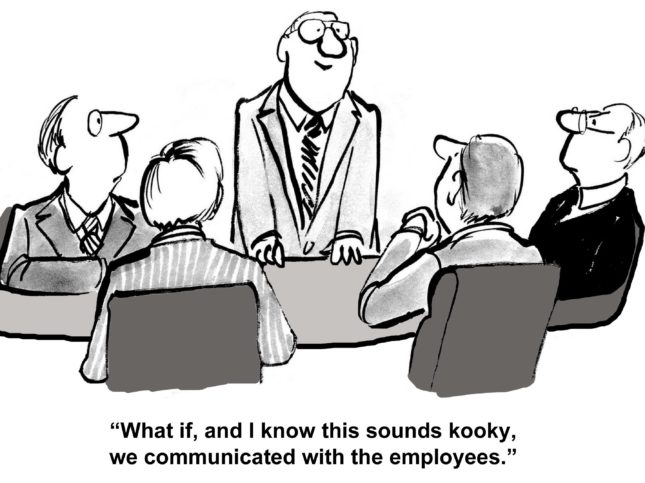Persuasion without Drama
Podcast: Play in new window | Download
We all admire the heroic view of persuasion, where the hero deploys his or her impeccable reasoning, formidable personality and eloquent words to sway an audience. Think 12 Angry Men, or Win One for the Gipper, or, for the more literary-minded, Mark Anthony’s eulogy for Caesar, where he artfully turned the anger of the mob away from Caesar and against his murderers. It’s easy to be fascinated, because that’s where the drama is.
But the most effective persuaders in the long run usually do it without the dramatics. They understand that, in the words of Sun Tzu, the best general is not the one who wins the most battles, but the one who wins without having to fight battles. I learned this on my own when I was a banker, and used to have to bring loan proposals to a committee for approval. After a few rough presentations, I learned to work the system. I would bring the rough version to one of the more influential members, for example, and ask his help in structuring the deal so that it would make sense. This not only gave me the benefit of his experience to improve the proposal, but also would get him committed to the deal, and I would then have an influential champion. I could then go to another member and say, “Chuck and I think____. What do you think?” (By the way, if you can’t find a champion for your idea before you go into the presentation, maybe you’d better reconsider the whole idea.)
I would also figure out quickly if there was going to be a deal-breaker, in which case I would “lose early”. This improved my overall success rate (and hence my reputation). It fed off itself, because with a reputation for bringing in sound proposals I found that I would get fewer questions from the group. I learned that trust must be painstakingly built brick by brick, over time; but once it’s built, assuming you don’t get complacent and do something stupid, it’s a gift that keeps on giving.
In large organizations the complexity of persuasion mushrooms because of the number of people involved. Strategic persuaders learn to figure out the informal paths of influence within the organization; they find out who has the most influence in each type of decision, how they perceive their interests, how they like to receive information, and dozens of other bits of information that go into completing the persuasion mosaic.
Because of their complexity, persuasion campaigns take on the character of a military campaign, where countless details need to be considered, resources marshaled on your behalf, allies to be lined up, and opponents’ moves and countermoves to be considered. Today’s military planners are taught to “shape the battlefield”; the last thing they want is a fair fight. For example, seasoned negotiators know that their personal performance at the negotiating table can only influence the final agreement within a narrow range that has been dictated already by the respective power and positioning of the participants.
Why You Need to Do This
Intelligence Gathering
The simplest reason is that it gives you a lot of information that you can use to then refine your proposal so that it’s as attractive as possible to the right people, and to address any possible objections.
Social Judgment Theory
The strongest message can fail to change someone’s mind if they’re not prepared to hear it. According to social judgment theory, there is a range of possible attitudes a person can take on an issue. Roughly, they can reject, accept, or be neutral about the issue.
But these three terms don’t really describe positions; they are more like zones, because there are differences within the zones, as you can see in the figure below.
The baseline is neutrality. Members of your audience may be indifferent or neutral for one of three reasons, apathy, ignorance or indecision.
The “negative” attitudes as they relate to your proposal are: skepticism, opposition, blocking.
The “positive” attitudes are: ally, coach, champion.
When you closely examine the range of positions that someone in the decision-making process can take, several critical considerations emerge.
First, there is a “latitude of acceptance” that each person is comfortable with. In most cases, people can be moved slightly from their current positions. It’s reasonable and possible to move someone from opposition to skepticism or even possibly neutrality.
But if you try to move people outside their latitude of acceptance, it is very difficult to do in one shot. No matter how charismatic or persuasive you are, it’s unlikely that you will get someone to do something they are strongly opposed to just because of one presentation. With people like that, the phrase “You can’t get there from here” applies.
In fact, if what you’re selling is too far outside their latitude of acceptance, you run the very real risk of a “boomerang effect”, meaning that your message will have the unintended effect of strengthening their opposition. In some cases, that means that it’s better not to even try—or at least dial down your target and expectations.
Second, it takes time to move people to the right. Our minds tend to resist change, and it can take time to soften the initial resistance… Think of it like trying to pull a heavy weight with a string. If you pull too hard or too suddenly, the string will snap. But if you apply a bit of pressure and then patiently add to it, you have a chance.
The Fix Is In
Amateurs rely on drama and passion in their presentations, while the professionals work behind the scenes to make things happen. As I’ve learned the hard way from trying to influence some decisions at our City Commission, by the time you show up, someone has already done what you should have been doing. Lobbyists know how to meet early and often with the right people, so that in most cases the decision is already made.
How to Shape the Conditions
Nemawashi
The Japanese call it “washing the roots”, and it’s all about socializing your idea before you show up. It may take more time up front, but it saves a lot of time in the long run.
Pack the crowd with your friends
Of course it’s important to know who will be in the audience and know what their stake is in the outcome, their potential objections, their history with similar decisions, etc. But you don’t have to passively accept the customer’s attendance list. One of the first mistakes that salespeople make in any complex sales cycle is to be so happy about getting their foot in the door that they don’t set certain conditions as the price for showing up. If it’s too easy to get that first meeting, you should remember Groucho Marx’s quip that he would not join any club that would take him as a member!
I once had a presentation set up with the Region President of a company in Detroit, and got his permission to reach out to some of the other attendees to make sure I could address their needs. That led to a conversation with his Director of Sales, which led to having dinner with him the night before, which resulted in a champion during the presentation.
Get them to put skin in the game
During the sales cycle, a lot of salespeople will do just about anything the buyer asks them to do, because they don’t want to take a chance on upsetting them. Although that’s usually a pretty good guide, it can actually hurt your sales effectiveness to give potential buyers everything they want.
First, astute buyers will recognize this and will lead you on a merry chase for the privilege of continuing to talk to them, even when they have no intention of buying from you. They will ask for more and more collateral material (which they will never read).
The key to qualifying the deal, and to increase your odds of success, is to get something back from your customer I return for complying with their request; in other words, sometimes you have to play hard to get.
If they want you to fly in from out of town for a meeting, make sure they invite others to the meeting as well. When a prospect (whom I had chased for months) asked me to come to Detroit to present to him, I told him I wasn’t sure I wanted to go. He was incredulous: “You’ve been trying to get through to me for months and now you’re not sure you want to come?”
I said, “I’m not convinced you’re serious. I don’t want to waste my time or yours unless you’re serious about this. Who else will you bring to the meeting?” In answer to my question, he agreed to give me time at his monthly meeting with all of his direct reports, and when I pressed further, allowed me to contact them before the meeting to make sure I could address their individual issues.
Did I take a risk in that situation? Of course; but I’d rather get a fast no than a long maybe. I pushed my luck a little in that situation, but here’s what it did for me:
- It helped me gauge how serious he was
- It earned me some respect and leveled the playing field between us
- In setting up the meeting, he was in effect “selling” me to his direct reports
But make sure your opponents are there, too
It may be counterintuitive, but you also want to do the same thing with your potential opponents. Make sure they all attend and try to talk to them before the meeting if possible. They need to be there during your presentation, because if they’re not, you won’t be able to answer their objections or concerns. They can wait until after the presentation and then do their internal selling against you and you won’t be able to do a thing about it.
By talking to them before the presentation, you have a chance to prepare for their concerns, and potentially to gain some respect. Simply ask them questions to sincerely understand their point of view and answer any questions they might have, but don’t try to “sell” them or change their minds, or you run the risk of entrenching their opposition.






